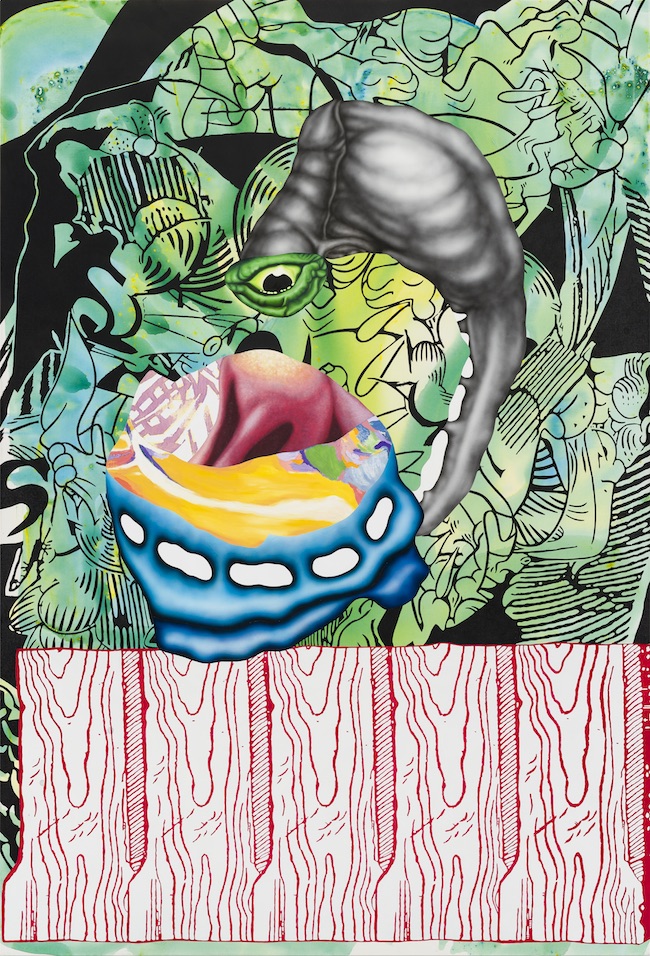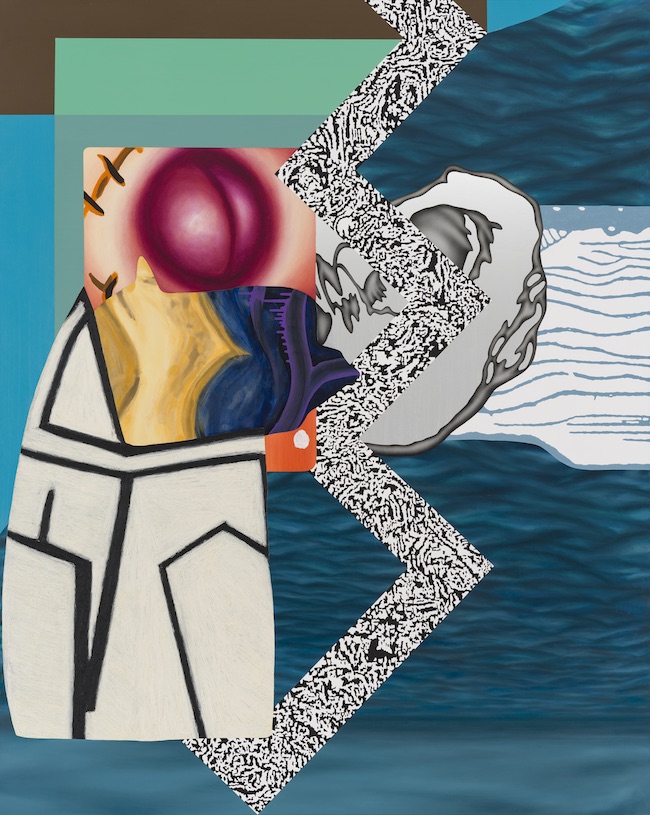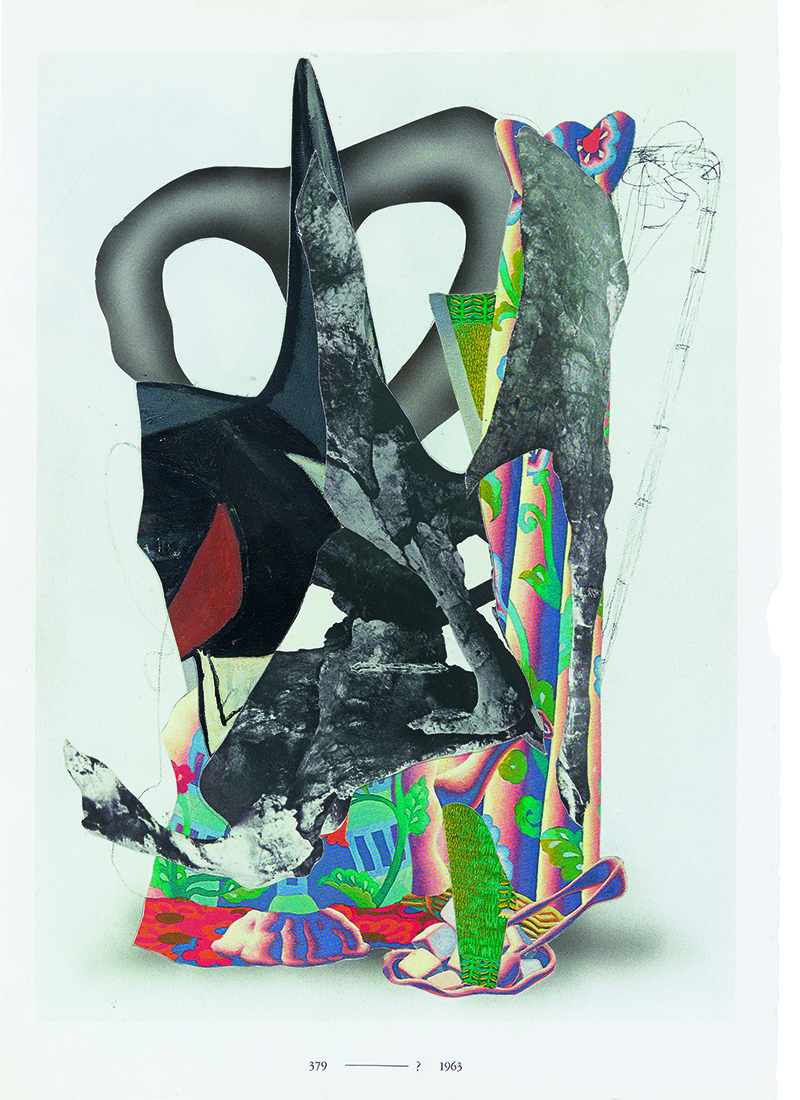In July 2017, Galerie Judin will open its doors for John Kleckner’s first painting-focused exhibition ‘Years Disappear.’ Within his new body of work, John Kleckner transcends any painterly categorisation. The Iowa-born, Berlin-based artist is renowned for his intricately composed ink drawings, yet this exhibition will reveal fresh produce from his ventures over the past five years; his pursuits in treating painting as a form of expanded collage. Constantly pushing the boundaries of what is achievable through the medium, Kleckner demonstrates his ability to convey several different styles of painting on one canvas, whilst simultaneously maintaining a personalised one of his own. Characterised by stylistic contrast and disjuncture between visual motifs, Kleckner’s work throws our understanding of painting’s style binaries into turmoil.

John Kleckner: ‘On the Fence’, 2015, oil, acrylic and flashe on canvas, 220 × 150 cm // © John Kleckner, Courtesy Galerie Judin
Entering the gallery, the paintings confront us with optical illusions, textures, and coiling visceral entities. Surreal and jarring, one can easily become transfixed by the morphing forms of his painting, which themselves seem to vibrate irrepressibly within the confines of the canvases. Despite commanding the gallery enclosure, the paintings only constitute part of a larger body of work produced for this show. Within the exhibition, Kleckner also presents us with the essential stimulant to his assemblage-esque creative process; twelve A4-size collages, all created on the pages taken from a book of drawings by Joseph Beuys. Showing found material merged with his own drawings, the collages momentarily gesture towards his earlier work in figurative drawing whilst also evidencing his insatiable curiosity towards the potentials of appropriating and re-configuring disparate visual motifs.
We spoke with the artist before the opening of the exhibition, which will run from July 4th until August 19th.
Katharine Doyle: ‘Years Disappear’ is intended to signify your return to the medium of painting, within which you have combined contrasting styles into finalised creations. And these paintings display more pronounced abstraction than your previous work. Could you explain your premise for this disjuncture in images and motifs, and how this has been part of the progression of your work?:
John Kleckner: Stylistic contrast is integral to the paintings, they’re based on this juxtaposition and this connection between material very deeply connected to collage, and that’s what collage can do so well. I think this has been something I’ve been attracted to more than ‘inventing’, like the typical Abstract Expressionist painter who stands in front of a canvas and invents the imagery or the painting. I would rather arrange and juxtapose things by planning them out. I actually have that fear of the blank white canvas and what to do with it. For me, one of the most important qualities of these paintings is how I handle the edge. In my paintings, there’s often really harsh cuts and strict edges where things just abruptly end. And those come from the original collage, from whatever materials or fragments I was working with. And I like to preserve that. One way to think about these paintings is as if several different genres of paintings have collided with one another and become entangled; as if they can’t pull themselves apart. I guess part of this stylistic incongruity is trying to keep myself engaged and challenged and exploring. There are still quite a few recurring motifs, such as the black and white shapes, and the colour gradient angle features. There’s certain fragments that I’m hooked on, and they have specific meaning, and I’m trying to re-use them and recycle them, never quite the same way so they almost develop new meaning as you move throughout the exhibition.

John Kleckner: ‘Pressure Point’, 2016, oil, acrylic and flashe on canvas, 200 × 160 cm // © John Kleckner, Courtesy Galerie Judin
KD: You have described the translation of your collages into paintings as ‘carefully planned accidents.’ Can you explain what you mean by this?:
JK: It was something that I said off the cuff in an interview, yet I think it’s really true. You know when people say ‘all paintings or art are self-portraits in some form,’ I think that this expression is really defining how I work; the fear of the blank white canvas is too much accident, too much of the unknown. I need more of the ‘carefully planned’, but not too much, because then it is stiff and dead. So, if you can create space for accidents to happen within a framework, that is when I am functioning the best aesthetically or creatively in my studio. And my studio is like that, it is a room with boundaries, where all the accidents and the play happens, and it is very important to have that space to shut the door to the outside world. A part of the works is closely tied to an accident, like chance and serendipity, and this sort of spontaneity but also some carefully planned aspects, such as areas painted with a tiny brush. Beuys’s drawings provide a sort of framework for the collages, so they retain the page and title captions of Beuys’s works, which then become the titles of my works. The twelve collages are not directly related to these paintings, the collages that I use to make the paintings don’t actually exist anymore. This is because I never actually glue the fragments down, because I don’t want them to exist, apart from when I am painting. The collages are very different and their own individual works, just more to give viewers a sense of the experiments behind the paintings. The collages are the accidents, and the paintings are the more carefully planned.
KD: Your work is shaped by a huge breadth of resources, and you collect a lot of material, from art historical references to horror-movie story books. Could you speak about how these influences and these choices of resources have informed the content of this body of work?
JK: A lot of those influences and resources are things which I’ve been gathering for over ten years. And even the earliest works I was exhibiting, these detailed pen drawings from a decade ago were relying upon the same resources. It’s things that have stuck in my mind and certain interests I have, like biology and anatomy.
For example, the silver pieces in one painting come from an anatomy textbook about the human brain. Art history is a significant area I come back to. It began with me trying to engage with all those influences one has and struggles with, especially when you are trying to find your own voice in art, so they were like rhetorical questions to myself, or to a past self about these preferences. As the collages develop it really allowed me to dig into this.
I’m often more interested in how a fragment works within a whole than the whole it comes from. Within both the exhibition and the combining of the resources, it really comes down to arranging fragments then seeing what happens. You can take a film still from a horror movie next to a piece of some ‘80s poster design and some abstract expressionist painting and just let something happen, because of their proximity and their context. The topics that I’m interested in are often very personal and so these fragments are all chosen with a kind of hidden meaning. If I reveal why I am interested in these things, it cuts the meaning down and narrows the scope for interpretation. I need to have that emotional connection to the fragments and I hope that that is communicated, but that is up to the audience to decide how they interpret my work.
KD: Even though you emphasise your work being part of an intuitive process of selecting the visual content for your paintings, it sounds like the associations they communicate are still important to you. That being the fact that your viewers might pick up on something even if they can’t instantly identify what it is, they still have their own subjective response to it. How would you ideally hope that people read your paintings?
JK: I would hope that people think of the elements in these paintings as fragments. And a fragment as a piece removed from something, and the rest of it can be unknown. I like a certain ambiguity there. I hope that these works are very difficult to consider according to the classic dichotomy of ‘is this an abstract painting or is it a figurative painting?’ I think of them as more on the abstract side of the spectrum, but everything comes from somewhere, and everything is rendered and depicted in a very specific way. It’s depicted but you can’t quite name what you’re seeing. There are occasions where I have crossed that line, for example including a big green eye in ‘On the Fence.’ But mostly I want the viewer to be drawn in and hang around in this space of questioning what they are seeing. I want that uncertainty and ambiguity in the viewing experience.
KD: What do you aesthetically hope to achieve through this body of work?
JK: On a personal level, I would like this body of work to establish this new chapter in my art practice, one that is oriented towards painting. In a bigger sense, I hope that this is offering something new, to add to the artistic dialogue around painting, including a mix of this digital aesthetic with some specific art historical references. My hope is that people are interested, and that this advances the conversation around what constitutes painting.
Exhibition Info
GALERIE JUDIN
John Kleckner: ‘Years Disappear’
Exhibition: Jul. 04 – Aug. 19, 2017
Opening Reception: Jul. 02, 2017; 4PM-7PM
Potsdamer Strasse 83, 10785 Berlin, click here for map

























